Victorian Institute of Technology: ML for Human Population Movement
VerifiedAdded on 2022/09/17
|5
|1432
|20
Report
AI Summary
This research report, prepared for the Victorian Institute of Technology's MITS Advanced Research Techniques course, investigates the application of machine learning to track and project human population movement through the Internet of Things (IoT). The report begins with an extended abstract summarizing the core concepts, including the integration of IoT devices, data collection via sensors, and the utilization of machine learning algorithms for data analysis and predictive modeling. The introduction further elaborates on the IoT ecosystem, emphasizing the role of smart devices and the benefits of real-time data for businesses and authorities. The study focuses on the effectiveness of machine learning in providing accurate forecasts of population movement by analyzing data gathered from IoT sensors. It highlights the potential of these algorithms to autonomously process data and generate reliable projections, aiding authorities in making informed decisions related to population control and resource allocation. The report references several academic sources that support the use of machine learning and IoT in various applications, including smart cities and disease prediction, emphasizing the importance of real-time data for effective analysis and prediction. The conclusion of the report would likely summarize the findings and suggest potential future research directions.
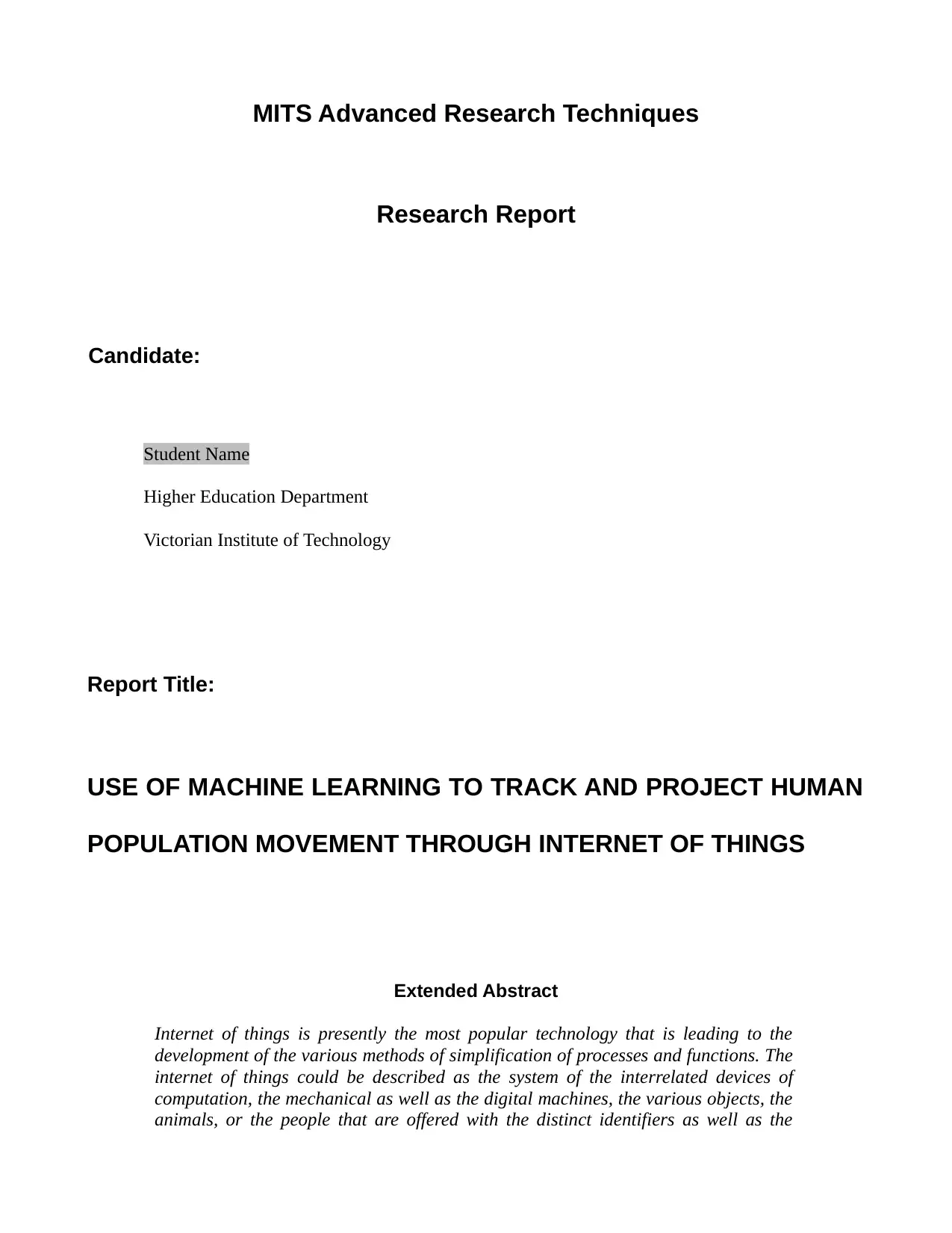
MITS Advanced Research Techniques
Research Report
Candidate:
Student Name
Higher Education Department
Victorian Institute of Technology
Report Title:
USE OF MACHINE LEARNING TO TRACK AND PROJECT HUMAN
POPULATION MOVEMENT THROUGH INTERNET OF THINGS
Extended Abstract
Internet of things is presently the most popular technology that is leading to the
development of the various methods of simplification of processes and functions. The
internet of things could be described as the system of the interrelated devices of
computation, the mechanical as well as the digital machines, the various objects, the
animals, or the people that are offered with the distinct identifiers as well as the
Research Report
Candidate:
Student Name
Higher Education Department
Victorian Institute of Technology
Report Title:
USE OF MACHINE LEARNING TO TRACK AND PROJECT HUMAN
POPULATION MOVEMENT THROUGH INTERNET OF THINGS
Extended Abstract
Internet of things is presently the most popular technology that is leading to the
development of the various methods of simplification of processes and functions. The
internet of things could be described as the system of the interrelated devices of
computation, the mechanical as well as the digital machines, the various objects, the
animals, or the people that are offered with the distinct identifiers as well as the
Paraphrase This Document
Need a fresh take? Get an instant paraphrase of this document with our AI Paraphraser
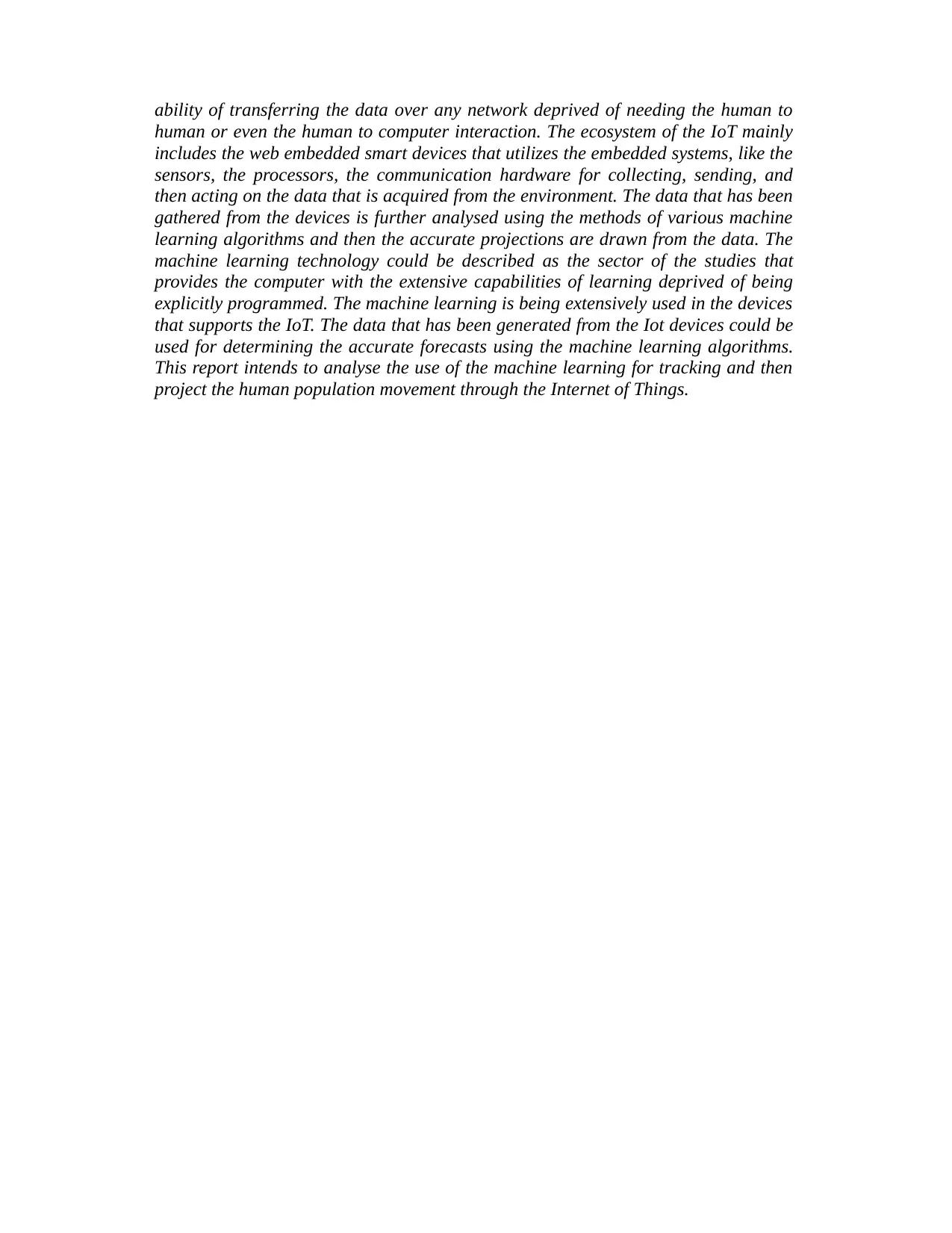
ability of transferring the data over any network deprived of needing the human to
human or even the human to computer interaction. The ecosystem of the IoT mainly
includes the web embedded smart devices that utilizes the embedded systems, like the
sensors, the processors, the communication hardware for collecting, sending, and
then acting on the data that is acquired from the environment. The data that has been
gathered from the devices is further analysed using the methods of various machine
learning algorithms and then the accurate projections are drawn from the data. The
machine learning technology could be described as the sector of the studies that
provides the computer with the extensive capabilities of learning deprived of being
explicitly programmed. The machine learning is being extensively used in the devices
that supports the IoT. The data that has been generated from the Iot devices could be
used for determining the accurate forecasts using the machine learning algorithms.
This report intends to analyse the use of the machine learning for tracking and then
project the human population movement through the Internet of Things.
human or even the human to computer interaction. The ecosystem of the IoT mainly
includes the web embedded smart devices that utilizes the embedded systems, like the
sensors, the processors, the communication hardware for collecting, sending, and
then acting on the data that is acquired from the environment. The data that has been
gathered from the devices is further analysed using the methods of various machine
learning algorithms and then the accurate projections are drawn from the data. The
machine learning technology could be described as the sector of the studies that
provides the computer with the extensive capabilities of learning deprived of being
explicitly programmed. The machine learning is being extensively used in the devices
that supports the IoT. The data that has been generated from the Iot devices could be
used for determining the accurate forecasts using the machine learning algorithms.
This report intends to analyse the use of the machine learning for tracking and then
project the human population movement through the Internet of Things.
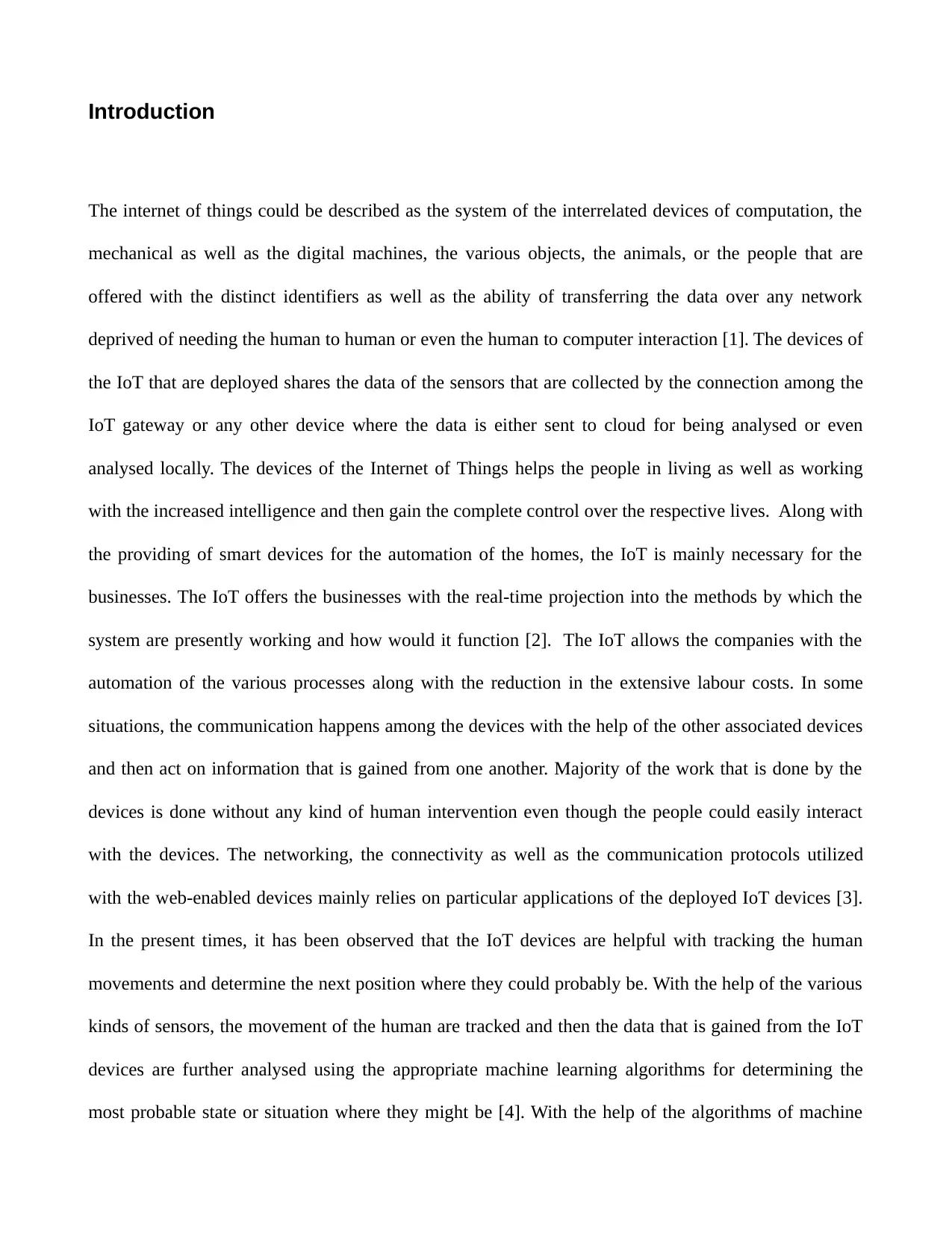
Introduction
The internet of things could be described as the system of the interrelated devices of computation, the
mechanical as well as the digital machines, the various objects, the animals, or the people that are
offered with the distinct identifiers as well as the ability of transferring the data over any network
deprived of needing the human to human or even the human to computer interaction [1]. The devices of
the IoT that are deployed shares the data of the sensors that are collected by the connection among the
IoT gateway or any other device where the data is either sent to cloud for being analysed or even
analysed locally. The devices of the Internet of Things helps the people in living as well as working
with the increased intelligence and then gain the complete control over the respective lives. Along with
the providing of smart devices for the automation of the homes, the IoT is mainly necessary for the
businesses. The IoT offers the businesses with the real-time projection into the methods by which the
system are presently working and how would it function [2]. The IoT allows the companies with the
automation of the various processes along with the reduction in the extensive labour costs. In some
situations, the communication happens among the devices with the help of the other associated devices
and then act on information that is gained from one another. Majority of the work that is done by the
devices is done without any kind of human intervention even though the people could easily interact
with the devices. The networking, the connectivity as well as the communication protocols utilized
with the web-enabled devices mainly relies on particular applications of the deployed IoT devices [3].
In the present times, it has been observed that the IoT devices are helpful with tracking the human
movements and determine the next position where they could probably be. With the help of the various
kinds of sensors, the movement of the human are tracked and then the data that is gained from the IoT
devices are further analysed using the appropriate machine learning algorithms for determining the
most probable state or situation where they might be [4]. With the help of the algorithms of machine
The internet of things could be described as the system of the interrelated devices of computation, the
mechanical as well as the digital machines, the various objects, the animals, or the people that are
offered with the distinct identifiers as well as the ability of transferring the data over any network
deprived of needing the human to human or even the human to computer interaction [1]. The devices of
the IoT that are deployed shares the data of the sensors that are collected by the connection among the
IoT gateway or any other device where the data is either sent to cloud for being analysed or even
analysed locally. The devices of the Internet of Things helps the people in living as well as working
with the increased intelligence and then gain the complete control over the respective lives. Along with
the providing of smart devices for the automation of the homes, the IoT is mainly necessary for the
businesses. The IoT offers the businesses with the real-time projection into the methods by which the
system are presently working and how would it function [2]. The IoT allows the companies with the
automation of the various processes along with the reduction in the extensive labour costs. In some
situations, the communication happens among the devices with the help of the other associated devices
and then act on information that is gained from one another. Majority of the work that is done by the
devices is done without any kind of human intervention even though the people could easily interact
with the devices. The networking, the connectivity as well as the communication protocols utilized
with the web-enabled devices mainly relies on particular applications of the deployed IoT devices [3].
In the present times, it has been observed that the IoT devices are helpful with tracking the human
movements and determine the next position where they could probably be. With the help of the various
kinds of sensors, the movement of the human are tracked and then the data that is gained from the IoT
devices are further analysed using the appropriate machine learning algorithms for determining the
most probable state or situation where they might be [4]. With the help of the algorithms of machine
⊘ This is a preview!⊘
Do you want full access?
Subscribe today to unlock all pages.

Trusted by 1+ million students worldwide
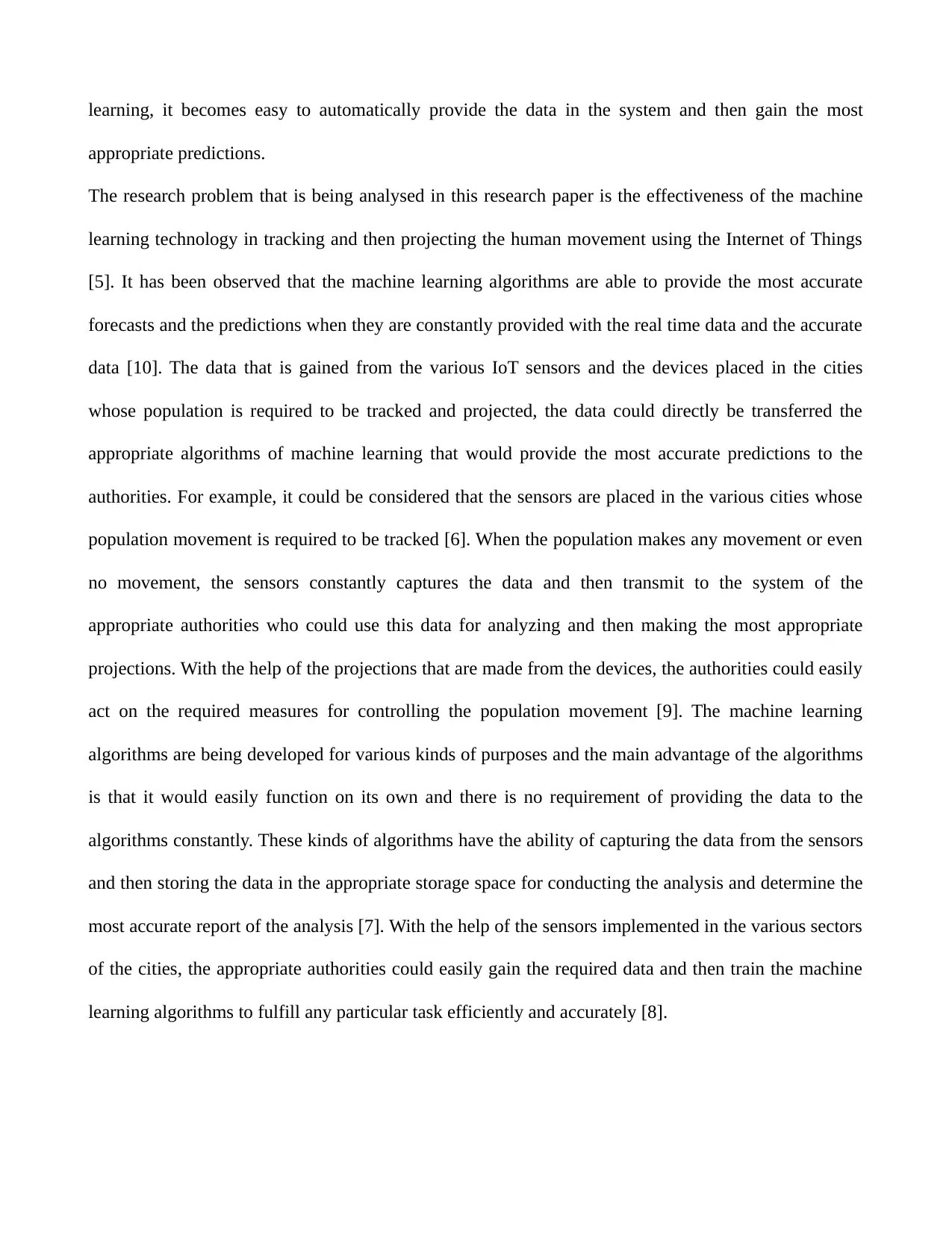
learning, it becomes easy to automatically provide the data in the system and then gain the most
appropriate predictions.
The research problem that is being analysed in this research paper is the effectiveness of the machine
learning technology in tracking and then projecting the human movement using the Internet of Things
[5]. It has been observed that the machine learning algorithms are able to provide the most accurate
forecasts and the predictions when they are constantly provided with the real time data and the accurate
data [10]. The data that is gained from the various IoT sensors and the devices placed in the cities
whose population is required to be tracked and projected, the data could directly be transferred the
appropriate algorithms of machine learning that would provide the most accurate predictions to the
authorities. For example, it could be considered that the sensors are placed in the various cities whose
population movement is required to be tracked [6]. When the population makes any movement or even
no movement, the sensors constantly captures the data and then transmit to the system of the
appropriate authorities who could use this data for analyzing and then making the most appropriate
projections. With the help of the projections that are made from the devices, the authorities could easily
act on the required measures for controlling the population movement [9]. The machine learning
algorithms are being developed for various kinds of purposes and the main advantage of the algorithms
is that it would easily function on its own and there is no requirement of providing the data to the
algorithms constantly. These kinds of algorithms have the ability of capturing the data from the sensors
and then storing the data in the appropriate storage space for conducting the analysis and determine the
most accurate report of the analysis [7]. With the help of the sensors implemented in the various sectors
of the cities, the appropriate authorities could easily gain the required data and then train the machine
learning algorithms to fulfill any particular task efficiently and accurately [8].
appropriate predictions.
The research problem that is being analysed in this research paper is the effectiveness of the machine
learning technology in tracking and then projecting the human movement using the Internet of Things
[5]. It has been observed that the machine learning algorithms are able to provide the most accurate
forecasts and the predictions when they are constantly provided with the real time data and the accurate
data [10]. The data that is gained from the various IoT sensors and the devices placed in the cities
whose population is required to be tracked and projected, the data could directly be transferred the
appropriate algorithms of machine learning that would provide the most accurate predictions to the
authorities. For example, it could be considered that the sensors are placed in the various cities whose
population movement is required to be tracked [6]. When the population makes any movement or even
no movement, the sensors constantly captures the data and then transmit to the system of the
appropriate authorities who could use this data for analyzing and then making the most appropriate
projections. With the help of the projections that are made from the devices, the authorities could easily
act on the required measures for controlling the population movement [9]. The machine learning
algorithms are being developed for various kinds of purposes and the main advantage of the algorithms
is that it would easily function on its own and there is no requirement of providing the data to the
algorithms constantly. These kinds of algorithms have the ability of capturing the data from the sensors
and then storing the data in the appropriate storage space for conducting the analysis and determine the
most accurate report of the analysis [7]. With the help of the sensors implemented in the various sectors
of the cities, the appropriate authorities could easily gain the required data and then train the machine
learning algorithms to fulfill any particular task efficiently and accurately [8].
Paraphrase This Document
Need a fresh take? Get an instant paraphrase of this document with our AI Paraphraser
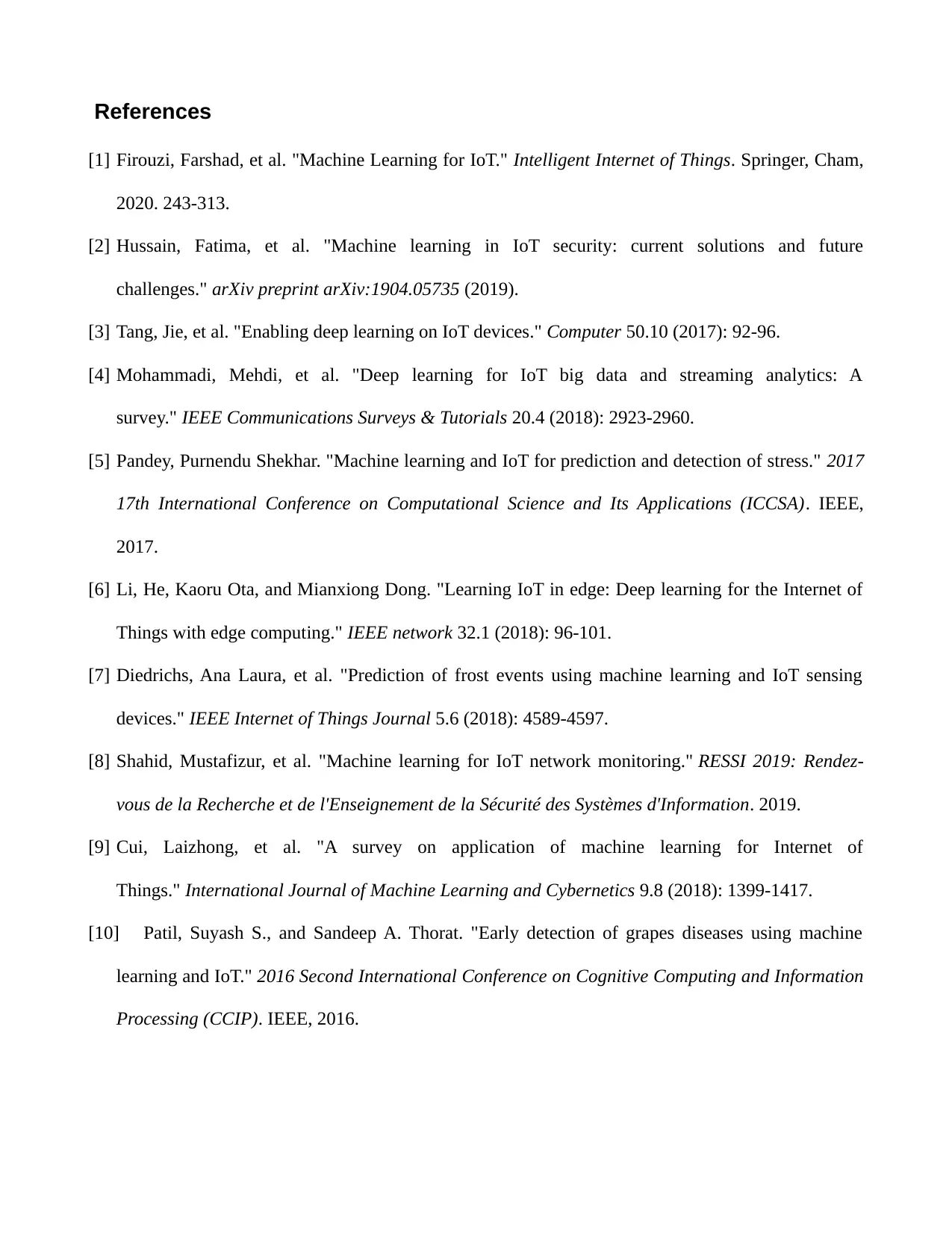
References
[1] Firouzi, Farshad, et al. "Machine Learning for IoT." Intelligent Internet of Things. Springer, Cham,
2020. 243-313.
[2] Hussain, Fatima, et al. "Machine learning in IoT security: current solutions and future
challenges." arXiv preprint arXiv:1904.05735 (2019).
[3] Tang, Jie, et al. "Enabling deep learning on IoT devices." Computer 50.10 (2017): 92-96.
[4] Mohammadi, Mehdi, et al. "Deep learning for IoT big data and streaming analytics: A
survey." IEEE Communications Surveys & Tutorials 20.4 (2018): 2923-2960.
[5] Pandey, Purnendu Shekhar. "Machine learning and IoT for prediction and detection of stress." 2017
17th International Conference on Computational Science and Its Applications (ICCSA). IEEE,
2017.
[6] Li, He, Kaoru Ota, and Mianxiong Dong. "Learning IoT in edge: Deep learning for the Internet of
Things with edge computing." IEEE network 32.1 (2018): 96-101.
[7] Diedrichs, Ana Laura, et al. "Prediction of frost events using machine learning and IoT sensing
devices." IEEE Internet of Things Journal 5.6 (2018): 4589-4597.
[8] Shahid, Mustafizur, et al. "Machine learning for IoT network monitoring." RESSI 2019: Rendez-
vous de la Recherche et de l'Enseignement de la Sécurité des Systèmes d'Information. 2019.
[9] Cui, Laizhong, et al. "A survey on application of machine learning for Internet of
Things." International Journal of Machine Learning and Cybernetics 9.8 (2018): 1399-1417.
[10] Patil, Suyash S., and Sandeep A. Thorat. "Early detection of grapes diseases using machine
learning and IoT." 2016 Second International Conference on Cognitive Computing and Information
Processing (CCIP). IEEE, 2016.
[1] Firouzi, Farshad, et al. "Machine Learning for IoT." Intelligent Internet of Things. Springer, Cham,
2020. 243-313.
[2] Hussain, Fatima, et al. "Machine learning in IoT security: current solutions and future
challenges." arXiv preprint arXiv:1904.05735 (2019).
[3] Tang, Jie, et al. "Enabling deep learning on IoT devices." Computer 50.10 (2017): 92-96.
[4] Mohammadi, Mehdi, et al. "Deep learning for IoT big data and streaming analytics: A
survey." IEEE Communications Surveys & Tutorials 20.4 (2018): 2923-2960.
[5] Pandey, Purnendu Shekhar. "Machine learning and IoT for prediction and detection of stress." 2017
17th International Conference on Computational Science and Its Applications (ICCSA). IEEE,
2017.
[6] Li, He, Kaoru Ota, and Mianxiong Dong. "Learning IoT in edge: Deep learning for the Internet of
Things with edge computing." IEEE network 32.1 (2018): 96-101.
[7] Diedrichs, Ana Laura, et al. "Prediction of frost events using machine learning and IoT sensing
devices." IEEE Internet of Things Journal 5.6 (2018): 4589-4597.
[8] Shahid, Mustafizur, et al. "Machine learning for IoT network monitoring." RESSI 2019: Rendez-
vous de la Recherche et de l'Enseignement de la Sécurité des Systèmes d'Information. 2019.
[9] Cui, Laizhong, et al. "A survey on application of machine learning for Internet of
Things." International Journal of Machine Learning and Cybernetics 9.8 (2018): 1399-1417.
[10] Patil, Suyash S., and Sandeep A. Thorat. "Early detection of grapes diseases using machine
learning and IoT." 2016 Second International Conference on Cognitive Computing and Information
Processing (CCIP). IEEE, 2016.
1 out of 5
Related Documents
Your All-in-One AI-Powered Toolkit for Academic Success.
+13062052269
info@desklib.com
Available 24*7 on WhatsApp / Email
![[object Object]](/_next/static/media/star-bottom.7253800d.svg)
Unlock your academic potential
Copyright © 2020–2025 A2Z Services. All Rights Reserved. Developed and managed by ZUCOL.





